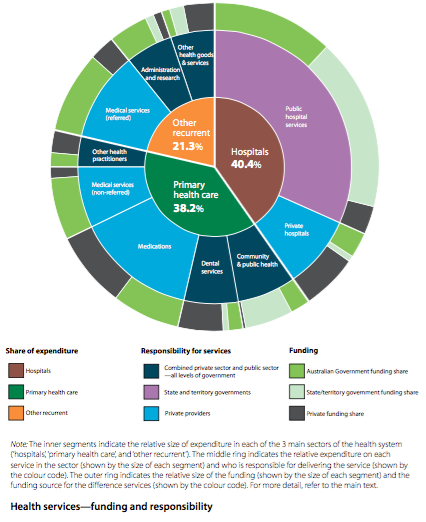Before reading through this page on responsibility for health facilities and services, take a moment to review Responsibility for health promotion – Government from Preliminary HSC.
Though various people and organisations are involved in the running and oversight of the health system, the people who have overall responsibility for health facilities and services are the Australian health ministers (Commonwealth & state) – referred to as the Standing Council on Health. The running of the individual systems falls to the relevant health ministers and health departments in each jurisdiction.
The standing council implement the Governments national health reforms and focus on achieving ‘a better health service and a more sustainable health system for Australia’, and on closing the gap between Indigenous and non-Indigenous Australians (AHMAC 2013). Its areas of responsibility include, but are not limited to:
- Hospitals
- Community health
- Primary health care
- Health promotion
- Mental health
- National Drug Strategy
- Aged care etc.
The Australian Health Ministers’ Advisory Council, made up of heads of health authorities, supports the standing council.
The state and territory governments regulate the health system. They licence private hospitals and use legislation to operate public hospitals. They regulate the sale and supply of tobacco and alcohol, the safety of pharmaceuticals, goods, appliances, blood products and private health insurers. The National Registration and Accreditation Scheme regulate health professionals.
| Expenditure | Hospitals (public & private) | Primary health care (GP, physiotherapy and optometry services, dental services and all community and public health initiatives, and medications) | Other recurrent (medical services other than those provided by GPs, medical research, health aids and appliances, patient transport services and health administration) |
| Responsibility | Combined private & public sector (all levels of Government) – Roughly half of other recurrent expenditure, specifically: health goods and services, and administration and research – Some of the primary health care, including: community and public health, dental services and other health practitioners | State & Territory governments – All the public hospital services | Private providers – All private Hospital services – Much of the primary health services, especially: medications, and other medical services – The other half of the other recurrent expenditure and its un-referred medical services. |
| Funding | Commonwealth Government – Much of both public and private hospitals – Much of the primary health services, including: medications, medical services and community health services – Much of the recurrent expenditure including: research and medications | State/Territory Governments – Most of the public hospitals and some of the private – Much of the community and public health in the primary health services – Some administrative, research and other health goods in the recurrent expenditure | Private funding – Most of the private hospital and some of the public hospital services – Most of the dental, medical and other health practitioners – Some other goods and services and a small amount of the referred medical services |
Summary of government responsibilities
Commonwealth
State/Territory
Local
policy and legislation, funding to state/territory, hospitals, fund Medicare and PBS, and health promotion strategies
Health services including hospitals and mental health, women’s, Aboriginal, and dental. Help carry out health promotion.
Action policies including: WHS, parks and community spaces. Community health services and clinics, early childhood centres, local health promotion, waste disposal, and services such as meals on wheels.

